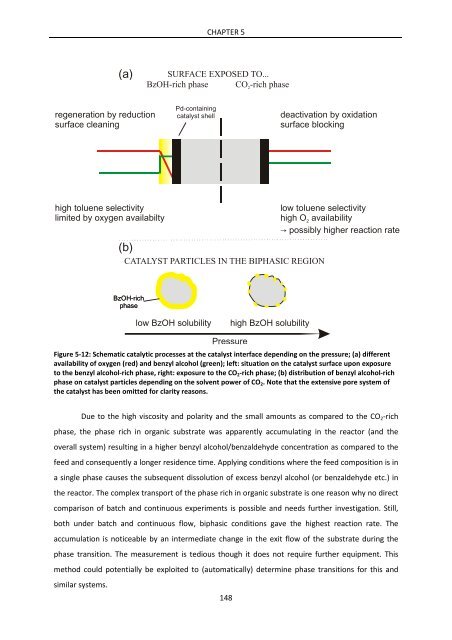Heterogeneously Catalyzed Oxidation Reactions Using ... - CHEC
Heterogeneously Catalyzed Oxidation Reactions Using ... - CHEC
Heterogeneously Catalyzed Oxidation Reactions Using ... - CHEC
Create successful ePaper yourself
Turn your PDF publications into a flip-book with our unique Google optimized e-Paper software.
egeneration by reduction<br />
surface cleaning<br />
high toluene selectivity<br />
limited by oxygen availabilty<br />
CHAPTER 5<br />
Figure 5‐12: Schematic catalytic processes at the catalyst interface depending on the pressure; (a) different<br />
availability of oxygen (red) and benzyl alcohol (green); left: situation on the catalyst surface upon exposure<br />
to the benzyl alcohol‐rich phase, right: exposure to the CO2‐rich phase; (b) distribution of benzyl alcohol‐rich<br />
phase on catalyst particles depending on the solvent power of CO2. Note that the extensive pore system of<br />
the catalyst has been omitted for clarity reasons.<br />
Due to the high viscosity and polarity and the small amounts as compared to the CO2‐rich<br />
phase, the phase rich in organic substrate was apparently accumulating in the reactor (and the<br />
overall system) resulting in a higher benzyl alcohol/benzaldehyde concentration as compared to the<br />
feed and consequently a longer residence time. Applying conditions where the feed composition is in<br />
a single phase causes the subsequent dissolution of excess benzyl alcohol (or benzaldehyde etc.) in<br />
the reactor. The complex transport of the phase rich in organic substrate is one reason why no direct<br />
comparison of batch and continuous experiments is possible and needs further investigation. Still,<br />
both under batch and continuous flow, biphasic conditions gave the highest reaction rate. The<br />
accumulation is noticeable by an intermediate change in the exit flow of the substrate during the<br />
phase transition. The measurement is tedious though it does not require further equipment. This<br />
method could potentially be exploited to (automatically) determine phase transitions for this and<br />
similar systems.<br />
(a)<br />
(b)<br />
SURFACE EXPOSED TO...<br />
BzOH-rich phase CO2-rich phase<br />
CATALYST PARTICLES IN THE BIPHASIC REGION<br />
BzOH-rich<br />
phase<br />
Pd-containing<br />
catalyst shell<br />
low BzOH solubility high BzOH solubility<br />
Pressure<br />
148<br />
deactivation by oxidation<br />
surface blocking<br />
low toluene selectivity<br />
high O 2 availability<br />
→ possibly higher reaction rate



